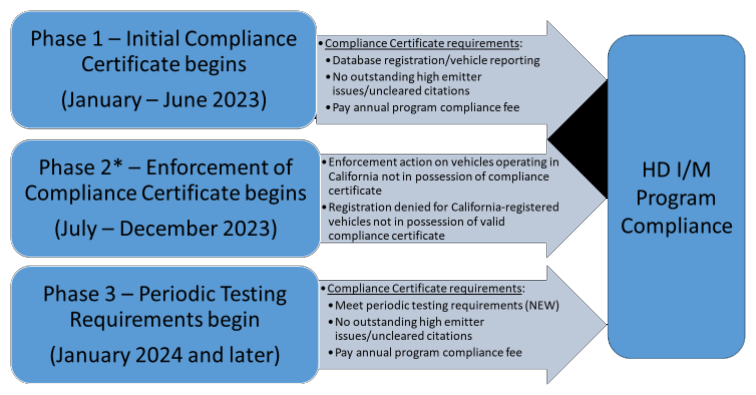Clean Truck Check Services
The California Air Resources Board (CARB) has been rebranded Heavy-Duty Inspection and Maintenance Regulation (HD I/M) as the “Clean Truck Check” Regulation.

In December of 2021, the California Air Resources Board approved for adoption the HD I/M program in an ongoing effort to meet air quality standards by ensuring heavy-duty vehicle emissions control systems are properly operating throughout the life of the vehicle. The program sets regular testing requirements for all non-gasoline heavy-duty trucks operating in the State and will be tied to DMV registration. Learn more about the requirements, exemptions, and timeline below.
Heavy-duty vehicles continue to be major contributors to statewide mobile air pollution even though this sector makes up only a small portion of California’s total on-road vehicle fleet. In 2020, these vehicles emitted about 52 percent of the statewide on-road mobile source NOx emissions and about 54 percent of the statewide on-road mobile source PM 2.5 emissions.
Modern trucks are equipped with aftertreatment systems like diesel particulate filters for controlling PM and selective catalytic reduction for cutting NOx. Although most heavy-duty truck owners take good care of their trucks and keep them low-emitting, a significant portion do not.
Recent CARB field testing of heavy-duty vehicles show 11 to 17 percent of tested onboard diagnostic (OBD) vehicles had illuminated OBD malfunction indicator light, suggesting significant number of heavy-duty vehicles are operating in California with malfunctioning emissions control systems. The proposed Heavy-Duty Inspection and Maintenance (HD I/M) program is aimed at ensuring all heavy-duty trucks operating in California are well maintained and repaired rapidly when needed, and ensuring a level playing field for the businesses that operate them.
Under the Clean Air Act, CARB is responsible for developing statewide programs and strategies to reduce smog-forming and toxic pollutants emitted from mobile sources. Heavy-duty diesel vehicles greater than 14,000 pounds are major contributors to California’s air quality challenges. These vehicles still contribute the majority of on-road NOx and PM 2.5 emissions, despite significant efforts by CARB over the last 40 years to reduce NOx and PM emissions from this sector. Previous efforts include regulations and programs for new engine standards, manufacturer warranties, and durability requirements for emission control components; in-use truck rules to accelerate fleet turnover; and incentive programs to promote innovative low- and zero-emitting technologies.
Modern heavy-duty diesel vehicles are equipped with aftertreatment systems like diesel particulate filters for controlling PM and selective catalytic reduction for cutting NOx emissions. However, when emissions control components malfunction, this may result in emissions increases that can stall efforts to achieve clean, healthy air in California’s communities. The HD I/M program will ensure heavy-duty vehicles operating in California are well-maintained and repaired rapidly when needed, and promote a level playing field for the businesses that operate them.
Through an integrated strategy combining roadside emissions monitoring to screen for potential high-emitting vehicles, improved emissions testing procedures using on-board diagnostics data, emissions checks and data reporting at required intervals, and compliance verification requirements for freight contractors, seaports, and railyards, the HD I/M regulation is one of the most impactful regulations approved in recent CARB history. When fully implemented, the regulation is projected to cut statewide NOx emissions by over 81 tons per day and PM emissions by 0.7 tons per day in 2037. Together, these emissions reductions will result in over 7,500 avoided premature deaths.
Above info supplied by The California Air Resources Board.

